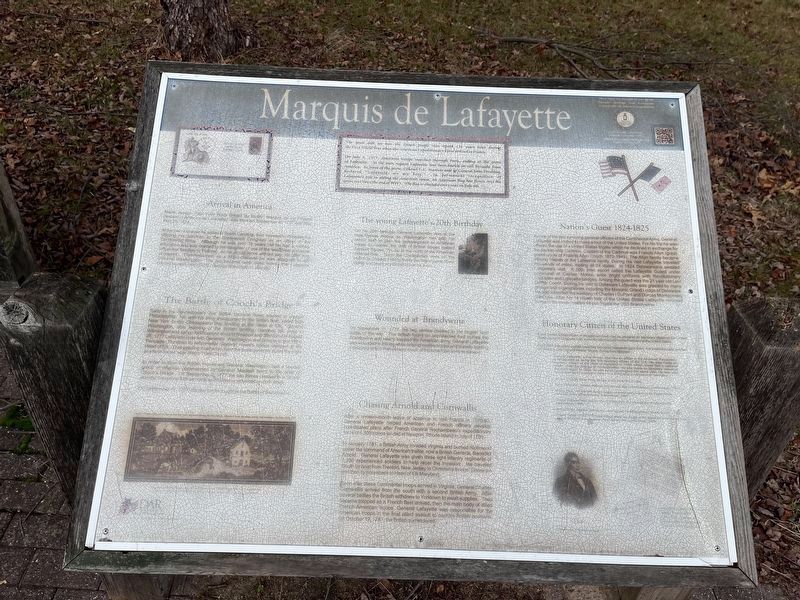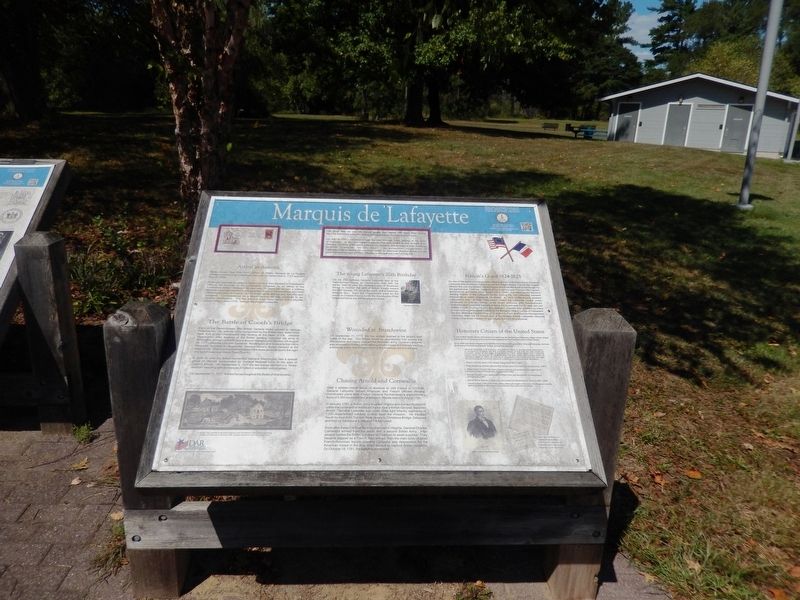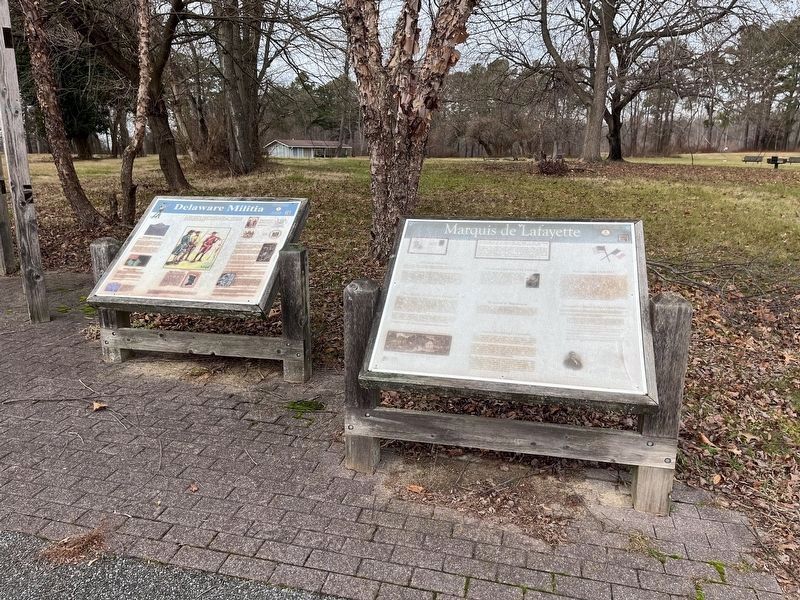Glasgow in New Castle County, Delaware — The American Northeast (Mid-Atlantic)
Marquis de Lafayette
The great debt we owe the French people was repaid 136 years later during the First World War when the American Expeditionary Force arrived in France.
On July 4, 1917, American troops marched through Paris, ending at the grave of Lafayette. At his own request Lafayette had been buried in soil brought from America. In front of the grave, Colonel C.E. Stanton aide to General John Pershing, declared “Lafayette, we are here.” In permanent recognition of Lafayette’s role in aiding the American cause, an American flag has flown over his grave ever since the end of WWI. The flag is changed every year on July 4th .
Arrival in America
Marie Joseph Paul Yves Roch Gilbert du Motier, Marquis de La Fayette (known in America as Lafayette) was born on September 6, 1757 and died on May 20, 1834.
At his own expense he sailed to South Carolina, then traveled to Philadelphia offering his services to the Continental Congress as an officer in the Continental Army. Although he was only 19 years old, he had a military education and was married to the daughter of one of the wealthiest and most influential families in France. As he would serve without pay, his offer was accepted. Commissioned as a Major General he was assigned to aid General Washington. The two became such close friends that Lafayette named his son, born 1779, George Washington Lafayette.
The Battle of Cooch’s Bridge
Early in the Revolutionary War, British General Howe wanted to capture Philadelphia. He, with his army transported by the British fleet, sailed from New York to the Chesapeake Bay landing at the Head of the Elk. General Washington, after learning of the British landing, marched his army to Wilmington and set up fortifications around Newport and Stanton. On August 26, 1777 Lafayette rode with Generals Washington and Greene to Iron Hill, in Pencader Hundred to reconnoiter General Howe’s troops camped at the Head of the Elk. That evening it rained so hard the three generals spent the night at a farm house near Welsh Tract Church.
In order to slow the British movement General Washington had a special group of rifleman commanded by General Maxwell hurry to the area of Cooch’s Bridge. On September 3, 1777 the two forces clashed in a “sharp skirmish” resulting with as many as 20 killed or wounded on both sides.
On September 11, 1777 the two forces fought at the Battle of Brandywine.
The young Lafayette’s 20th Birthday
On his 20th birthday General Lafayette was at the Hale-Byrnes House as Washington met with his senior staff to plan the redeployment of American troops to counter the shift of British troops toward Kennett Square, PA, far to the north of the American defense

Photographed By Devry Becker Jones (CC0), December 30, 2023
2. Marquis de Lafayette Marker
Unfortunately, the marker has weathered significantly.
Wounded at Brandywine
On September 11, 1777, the two armies clashed in the largest land battle of the war. The British found an unprotected ford across the Brandywine and nearly trapped the American army. General Lafayette was wounded in the leg while rallying nearby troops and bravely leading a delaying action that allowed much of the American army to escape.
Chasing Arnold and Cornwallis
After a sixteen-month leave of absence to visit France in 1779-80, General Lafayette helped American and French officers develop coordinated plans after French General Rochambeau’s expeditionary force of 4,500 troops landed at Newport, Rhode Island in July of 1780.
In January 1781, a British Army invaded Virginia and burned Richmond under the command of American traitor, now a British General, Benedict Arnold. General Lafayette was given three light infantry regiments of 1,200 experience soldiers to help repel the invasion. He traveled South by boat from Trenton, New Jersey to Christiana Bridge, Delaware and then by horseback to Head of the Elk, Maryland.
Soon after these Continental troops arrived in Virginia, General Charles Cornwallis arrived from the south with a second British Army. After several battles
Nation’s Guest 1824-1825
As one of the last surviving general officers of the Continental Army, General Lafayette was invited to make a tour of the United States. For his trip he was offered the use of a United States frigate which he declined in exchange for the packet-ship Cadmus. Captain of the Cadmus was Francis Allyn (great-grand-uncle of Francis Allyn Cooch 1873-1949). The Allyn family became lifelong friends of the Lafayette family. During his visit Lafayette traveled thousands of miles, visiting all 24 states. In 1824 Delawareans awaited Lafayette’s visit. A 200-man escort called the Lafayette Guard under command of Captain Moore, wore bright uniforms with Revolutionary cockades and Lafayette badges. Among the guard was the 21 year old Levi Griffith Cooch. During his visit to Delaware Lafayette was greeted by many groups and organizations including the Masonic Grand Lodge of Delaware. He also attended the wedding of Charles I DuPont and Dorcas Montgomery VanDyke. After his 14 month tour of the United States Lafayette returned home in the three-masted 44 gun frigate, the USS Brandywine.
Honorary Citizen of the United States
A non-United States citizen of exceptional merit may be declared an Honorary citizen of the United States by Act of Congress or by a proclamation issued by the President of the United States.
As of 2009 only seven people have had this honor bestowed upon them, five posthumously, and two, Sir Winston Churchill and Mother Teresa, during their lifetime.
• General Lafayette, a Frenchman who was an officer in the American Revolution, is recognized as being the first honorary citizen of the U.S. He was made an honorary citizen of the state of Maryland in 1783, which made him a national citizen under the Articles of Confederation. He was made an honorary citizen of Maryland again in 1823 as well as of Connecticut the same year. He was also recognized as an honorary citizen in a 2002 joint congressional resolution.
• Winston Churchill, British Prime Minister during World War II (1963)
• Raoul Wallenberg, Swedish diplomat who rescued Jews in the Holocaust, posthumously (1961)
• William Penn, 17th and 18th century English proprietor and governor of the English North American colony of Pennsylvania, posthumously (1964)
• Hannah Callowhill Penn, second wife of William Penn and administrator of Pennsylvania, posthumously (1964)
• Mother Teresa, Albanian Catholic nun, who founded the Missionaries of Charity in India (1996)
• Casimir Pulaski (1745-1779) Polish military officer who fought on the side of the American colonies against the British in the American Revolutionary War, posthumously (2009)
Erected by Pencader Heritage Area Association.
Topics and series. This historical marker is listed in this topic list: War, US Revolutionary. In addition, it is included in the Former U.S. Presidents: #01 George Washington series list.
Location. 39° 36.463′ N, 75° 43.609′ W. Marker is in Glasgow, Delaware, in New Castle County. Marker is on Pulaski Highway (U.S. 40). This marker is located on the grounds of Glasgow Park. Touch for map. Marker is at or near this postal address: 2275 Pulaski Highway, Newark DE 19702, United States of America. Touch for directions.
Other nearby markers. At least 8 other markers are within walking distance of this marker. Delaware Militia (here, next to this marker); The March Through Pencader (here, next to this marker); Mason Dixon Line & the Boundaries of Delaware (here, next to this marker); Exploring the Past of Pencader Hundred (here, next to this marker); The Hundreds of Delaware (a few steps from this marker); Historic Iron Ore Mining (a few steps from this marker); In the Beginning … (approx. half a mile away); a different marker also named The March Through Pencader (approx. half a mile away). Touch for a list and map of all markers in Glasgow.
Regarding Marquis de Lafayette. "a special group of rifleman" is found; last word should be "riflemen", plural.
Credits. This page was last revised on December 31, 2023. It was originally submitted on September 26, 2019, by Don Morfe of Baltimore, Maryland. This page has been viewed 349 times since then and 43 times this year. Last updated on March 15, 2021, by Carl Gordon Moore Jr. of North East, Maryland. Photos: 1. submitted on September 26, 2019, by Don Morfe of Baltimore, Maryland. 2, 3. submitted on December 31, 2023, by Devry Becker Jones of Washington, District of Columbia. • Bill Pfingsten was the editor who published this page.

